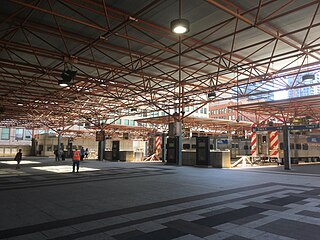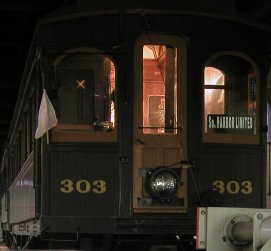
The Union Pacific Railroad is a Class I freight-hauling railroad that operates 8,300 locomotives over 32,200 miles (51,800 km) routes in 23 U.S. states west of Chicago and New Orleans. Union Pacific is the second largest railroad in the United States after BNSF, with which it shares a duopoly on transcontinental freight rail lines in the Western, Midwestern and West South Central United States.

BNSF Railway is the largest freight railroad in the United States. One of six North American Class I railroads, BNSF has 35,000 employees, 32,500 miles (52,300 km) of track in 28 states, and nearly 8,000 locomotives. It has three transcontinental routes that provide rail connections between the western and eastern United States. BNSF trains traveled over 169 million miles in 2010, more than any other North American railroad.
The Pennsylvania Railroad, legal name The Pennsylvania Railroad Company, also known as the "Pennsy", was an American Class I railroad that was established in 1846 and headquartered in Philadelphia. It was named for the commonwealth in which it was established. At its peak in 1882, the Pennsylvania Railroad was the largest railroad, the largest transportation enterprise, and the largest corporation in the world.

The Chicago, Rock Island and Pacific Railroad was an American Class I railroad. It was also known as the Rock Island Line, or, in its final years, The Rock.
Rail transport operations are the day-to-day operations of a railway. A railway has two major components: the infrastructure and the rolling stock

The Chicago and North Western was a Class I railroad in the Midwestern United States. It was also known as the "North Western". The railroad operated more than 5,000 miles (8,000 km) of track at the turn of the 20th century, and over 12,000 miles (19,000 km) of track in seven states before retrenchment in the late 1970s. Until 1972, when the employees purchased the company, it was named the Chicago and North Western Railway.

The Illinois Central Railroad, sometimes called the Main Line of Mid-America, was a railroad in the Central United States, with its primary routes connecting Chicago, Illinois, with New Orleans, Louisiana, and Mobile, Alabama, and thus, the Great Lakes to the Gulf of Mexico. A line also connected Chicago west to Sioux City, Iowa (1870). There was a significant branch to Omaha, Nebraska (1899), west of Fort Dodge, Iowa, and another branch reaching Sioux Falls, South Dakota (1877), starting from Cherokee, Iowa. The IC also serviced Miami, Florida, on trackage owned by other railroads

The Grand Trunk Western Railroad Company was an American subsidiary of the Grand Trunk Railway, later of the Canadian National Railway operating in Michigan, Illinois, Indiana, and Ohio. Since a corporate restructuring in 1971, the railroad has been under CN's subsidiary holding company, the Grand Trunk Corporation. Grand Trunk Western's routes are part of CN's Michigan Division. Its primary mainline between Chicago and Port Huron, Michigan serves as a connection between railroad interchanges in Chicago and rail lines in eastern Canada and the Northeastern United States. The railroad's extensive trackage in Detroit and across southern Michigan has made it an essential link for the automotive industry as a hauler of parts and automobiles from manufacturing plants.

A siding, in rail terminology, is a low-speed track section distinct from a running line or through route such as a main line, branch line, or spur. It may connect to through track or to other sidings at either end. Sidings often have lighter rails, meant for lower speed or less heavy traffic, and few, if any, signals. Sidings connected at both ends to a running line are commonly known as loops; those not so connected may be referred to as single-ended or dead-end sidings, or stubs.

The South Central Florida Express, Inc. is a common carrier shortline railroad in southern Florida run by U.S. Sugar Corporation. Its trains operate from Sebring to Fort Pierce via Clewiston around the southern perimeter of Lake Okeechobee, and serves customers at 26 locations. With 171 miles (275 km) of track, the SCXF is the largest private agricultural railroad in the U.S.

A rail yard, railway yard, railroad yard (US) or simply yard, is a series of tracks in a rail network for storing, sorting, or loading and unloading rail vehicles and locomotives. Yards have many tracks in parallel for keeping rolling stock or unused locomotives stored off the main line, so that they do not obstruct the flow of traffic. Cars or wagons are moved around by specially designed yard switcher locomotives (US) or shunter locomotives (UK), a type of locomotive. Cars or wagons in a yard may be sorted by numerous categories, including railway company, loaded or unloaded, destination, car type, or whether they need repairs. Yards are normally built where there is a need to store rail vehicles while they are not being loaded or unloaded, or are waiting to be assembled into trains. Large yards may have a tower to control operations.

Montana Rail Link is a privately held Class II railroad in the United States. It operates on trackage originally built by the Northern Pacific Railway and leased from its successor BNSF Railway. MRL is a unit of The Washington Companies and is headquartered in Missoula, Montana.

LaSalle Street Station is a commuter rail terminal at 414 South LaSalle Street in downtown Chicago. First used as a rail terminal in 1852, it was a major intercity rail terminal for the New York Central Railroad until 1968, and for the Chicago, Rock Island and Pacific Railroad until 1978, but now serves only Metra's Rock Island District. The present structure became the fifth station on the site when its predecessor was demolished in 1981 and replaced by the new station and the One Financial Place tower for the Chicago Stock Exchange. The Chicago Board of Trade Building, Willis Tower, and Harold Washington Library are nearby.

The Illinois Terminal Railroad Company, known as the Illinois Traction System until 1937, was a heavy duty interurban electric railroad with extensive passenger and freight business in central and southern Illinois from 1896 to 1956. When Depression era Illinois Traction was in financial distress and had to reorganize, the Illinois Terminal name was adopted to reflect the line's primary money making role as a freight interchange link to major steam railroads at its terminal ends, Peoria, Danville, and St. Louis. Interurban passenger service slowly was reduced, ending in 1956. Freight operation continued but was hobbled by tight street running in some towns requiring very sharp radius turns. In 1956, ITC was absorbed by a consortium of connecting railroads.

The Alton Railroad was the final name of a railroad linking Chicago to Alton, Illinois; St. Louis, Missouri; and Kansas City, Missouri. Its predecessor, the Chicago and Alton Railroad, was purchased by the Baltimore and Ohio Railroad in 1931 and was controlled until 1942 when the Alton was released to the courts. On May 31, 1947, the Alton Railroad was merged into the Gulf, Mobile and Ohio Railroad. Jacob Bunn had been one of the founding reorganizers of the Chicago & Alton Railroad Company during the 1860s.

The Toledo, Peoria and Western Railway is a short line railroad that operates 247 miles (398 km) of track from Mapleton, Illinois, through Peoria across Illinois to Logansport, Indiana. TP&W has trackage rights between Galesburg, Illinois, and Peoria, between Logansport and Kokomo, Indiana, and between Reynolds, Indiana, and Lafayette, Indiana. TPW has connections with UP, BNSF, NS, CSXT, CN, CP, BL, CERA, CIM, KBSR and T&P. The railroad is now owned by Genesee & Wyoming Inc. The railroad's traffic comes largely from agricultural products, including both raw and processed grain products, as well as chemicals and completed tractors. The TPW hauled around 26,000 carloads in 2008.

The Terminal Railroad Association of St. Louis is a Class III switching and terminal railroad that handles traffic in the St. Louis, Missouri, metropolitan area. It is co-owned by five of the six Class I railroads that reach the city.

The Tazewell & Peoria Railroad (T&P) is a short-line railroad, running entirely in Peoria County and Tazewell County, Illinois, and formed by Genesee & Wyoming Inc. to lease the assets of the century-old Peoria and Pekin Union Railway (P&PU), which is owned by Union Pacific, Norfolk Southern and Canadian National. It switches close to 100,000 cars per year and has about 142 miles of track. Genesee & Wyoming owns 81 miles of TZPR and can hold up to 286,000 pounds of supplies.

Cleveland has been and continues to be deeply rooted in railroad history.

The Illinois Northern Railroad was an industrial switching railroad serving Chicago's southwest side. From their yard at 26th St. and Western Ave. the line went southwest to the Santa Fe Railway's Corwith Yard, connecting with most major area railroads and serving on-line customers on the way. They also leased and switched track east of their yard. Incorporated in 1901, it was merged into the Santa Fe Railway in 1975.


















